UKRAINE RETURNS REPORT
GENERAL POPULATION SURVEY
ROUND 16
APRIL 2024


GENERAL POPULATION SURVEY
ROUND 16
APRIL 2024

GENERAL OVERVIEW AND KEY FINDINGS
SECTION 1: POPULATION FIGURES AND MOBILITY TRENDS
1.1 OVERVIEW AND CHANGE OVER TIME
1.2 PLACE OF LAST DISPLACEMENT PRIOR TO RETURN
1.3 TIME IN DISPLACEMENT, TIME SINCE RETURN, AND MOBILITY INTENTIONS
1.4 CROSSING BACK FROM ABROAD
1.5 DEMOGRAPHICS, CHARACTERISTICS AND SETTLEMENT TYPE
SECTION 2: PRIORITY NEEDS AND COPING STRATEGIES
2.1 OVERVIEW
2.2 RETURNEE NEEDS BY PROFILE AND LOCATION
2.3 CHANGE IN NEEDS OVER TIME
2.4 COPING STRATEGIES
ANNEX: ESTIMATED POPULATION BY DISPLACEMENT STATUS
Since the full-scale invasion of Ukraine by the Armed Forces of the Russian Federation, the International Organization for Migration (IOM) has been collecting data on internally displaced persons (IDPs), returnees, and the non-displaced population through a nationwide representative General Population Survey (GPS). The purpose of the assessment is to provide an in-depth, granular understanding of displacement figures and mobility trends, as well as to gather fundamental data on the profiles, needs and intentions of returnees in support of humanitarian efforts to find mechanisms to secure sustainable reintegration of returnees. The GPS, implemented on a quarterly basis, also provides key analysis of trends over time. To this end, the GPS conducts oblast-level, randomized interviews with a representative sample of each population group. This report covers Round 16 of the GPS, conducted in March-April 2024.
There are an estimated 4,734,000 returnees in Ukraine. The main oblasts of return are Kyiv City (where 22% of returnees reside), Kyivska, and Kharkivska Oblasts (about 15% each), with most returnees having returned more than a year ago (66%). People in Kyiv as well as the west, north and centre of Ukraine on average returned longer ago, while more recent returns were comparatively more concentrated in the East and South.
Almost half of all returnees (48%) returned from displacement in another oblast in Ukraine. Twenty-eight per cent of all returnees stated that they had spent at least 14 days abroad since February 2022 because of the full-scale war.
Five per cent of returnees (eqv. 228,000 individuals) were considering re-displacement (highest in Odeska Oblast, 9% of returnees).
The share of those crossing back into Ukraine from abroad intending to stay for more than one month (prospective returnees) decreased from 38 per cent in Q1 2023 to 25 per cent in Q1 2024.
Proximity to family and friends was the most commonly reported reason for returning to the place of origin (29%). This was followed by the availability of housing (20%), perceptions of employment opportunities (18%) and an improved security situation (16%).
Irrespective of rank, returnees reported food among their three main material and assistance needs (25%) with cash as the preferred modality for assistance (38%) or creation of employment opportunities (34%) so that respondents can meet this need sustainably.
Coping strategies, such as the spending of savings (57%) switching to cheaper food and NFIs (55%), alongside reducing utility expenditure (50%) continue to be used among high proportions of returnees.
The opinions expressed in this publication are those of the authors and do not necessarily reflect the views of the International Organization for Migration (IOM). The designations employed and the presentation of material throughout the publication do not imply expression of any opinion whatsoever on the part of IOM concerning the legal status of any country, territory, city or area, or of its authorities, or concerning its frontiers or boundaries.
IOM is committed to the principle that humane and orderly migration benefits migrants and society. As an intergovernmental organization, IOM acts with its partners in the international community to: assist in meeting the operational challenges of migration; advance understanding of migration issues; encourage social and economic development through migration; and uphold the human dignity and well-being of migrants.
© 2024 International Organization for Migration (IOM) All rights reserved. When quoting, paraphrasing or in any way using the information mentioned in this report, the source needs to be stated appropriately as follows: “Source: International Organization for Migration (IOM), Ukraine Displacement Report, April 2024”.
Map 1: Estimated returnee presence, by oblast of return
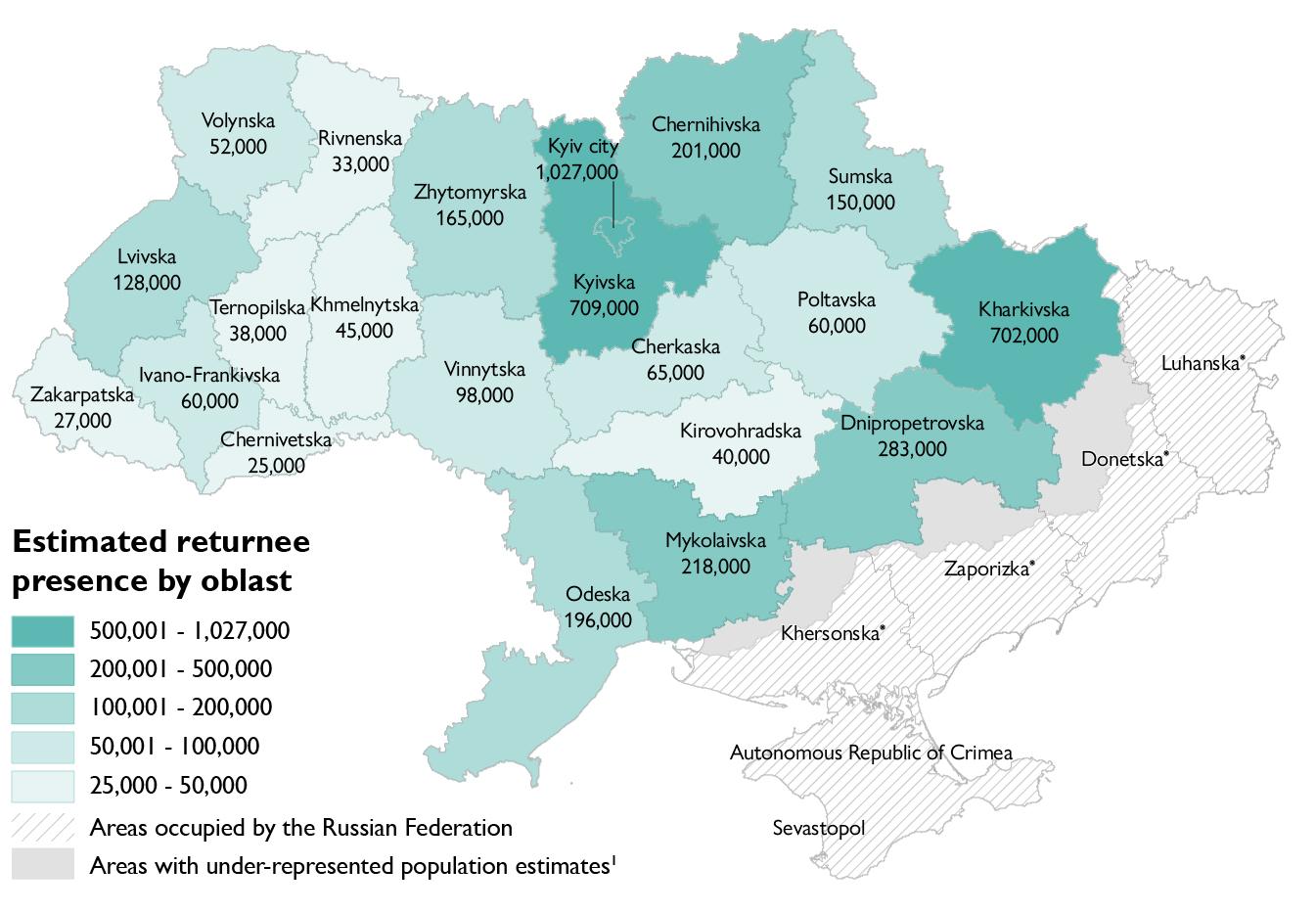
3,548,000
EST. TOTAL DE FACTO IDPs
Internally Displaced People (IDPs) are individuals who have been forced to flee or to leave their homes due to the full-scale invasion in February 2022, regardless of registration status.2
4,734,000
EST. TOTAL RETURNEES
Returnees are individuals who have returned to their habitual residence after a period of displacement of minimum two weeks since February 2022.3
Figure 1: Share of IDPs and returnees amongst the total population in Ukraine from Round 1(March 2022) to Round 16 (April 2024) and number of IDPs and returnees, as of 11 April 20244
1 Estimates in Donetska, Zaporizka, Luhanska, and Khersonska Oblasts are not represented due to their likely under-representation as a result of coverage being limited to government-controlled areas and to the limited number of respondents reached in occupied areas.
2 A complete definition of IDPs, as understood in the context of the General Population Survey, can be found in the Methodological Note on page 10.
3 A complete definition of returnees, as understood in the context of the General Population Survey, can be found in the Methodological Note on page 10.
4 The UNFPA Population Baseline, on the basis of which IDP and returnee population figures are extrapolated, underwent several changes between March 2022 and June 2023, impacting the comparability of population estimates over time. Trends unaffected by the extrapolation are shown by the line chart and expressed in % of the total population in Ukraine. Percentages have been rounded for visualization purposes. Between September 2023 and April 2024, the share of IDPs and returnees remained fairly stable reflecting a comparatively low rate of contextual change and widespread protracted displacement.
Figure 2: Location type in place of last displacement (% of returnees)

For nearly half of all returnees (48%), the location of last displacement was in another oblast within Ukraine. Just over a quarter of returnees (28%) had last been displaced within their oblast of origin. A further 24 per cent reported having returned from abroad, 86 per cent of which returned from a country in the European Union.
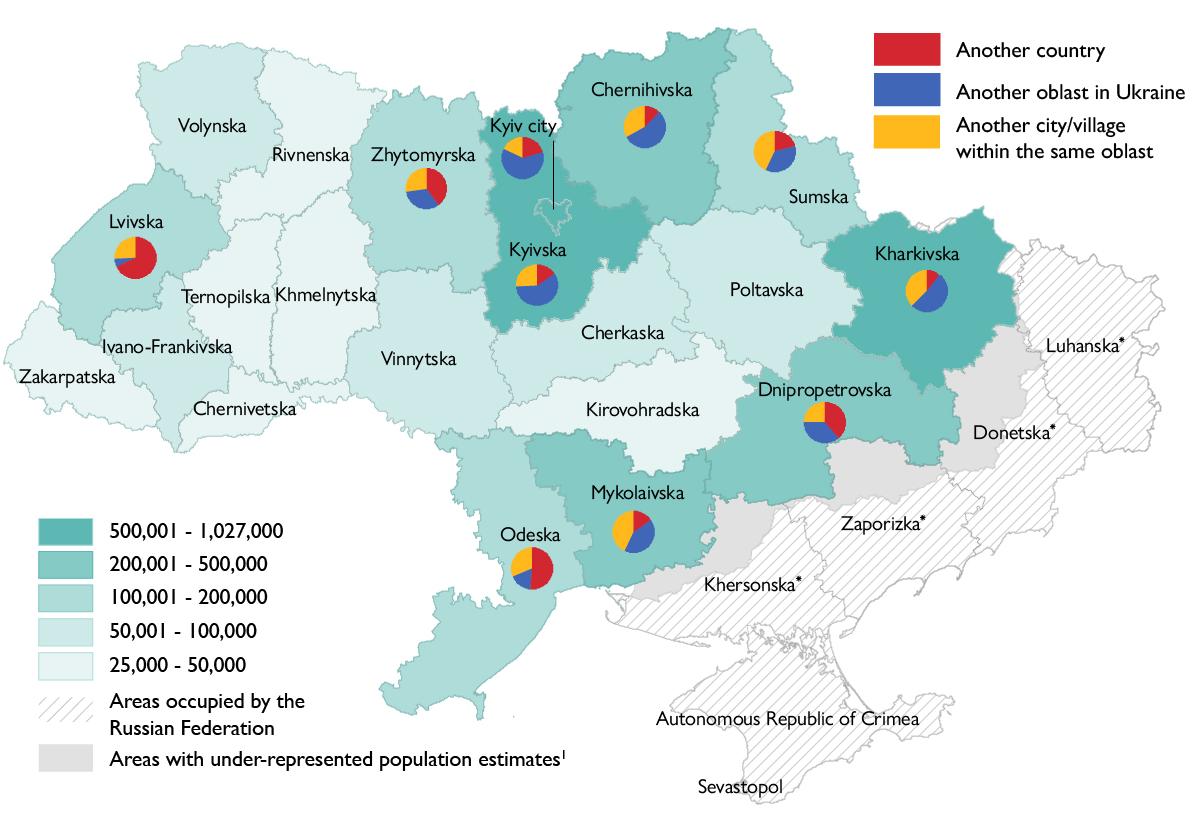
Proportions of returnees from abroad – people who most recently displaced abroad and have since returned to their place of habitual residence –were most prevalent in the west of Ukraine (62% of returnees in the West macro-region). Returns from within the same oblast (latest displacement location) were more prevalent in Sumska (43%), Mykolaivska (43%), Kharkivska (37%), Chernihivska (33%) and Odeska (31%) Oblasts. The key drivers of return within oblasts in these regions were the availability of affordable housing in places of origin, the desire to be closer to friends and family, and perceived ability to earn a better income in the place of origin. Returns from another oblast in Ukraine were most prevalent in Donetska Oblast (85%) and Kyiv City (61%).
Among all returnees having returned from within Ukraine more than a year ago, 10 per cent returned from Lviv Oblast, compared to 5 per cent who returned from Kharkiv Oblast. In contrast, 13 per cent of returnees having returned more recently (up to 1 year ago) returned from Kharkivska Oblast, compared to only 6 per cent who still returned from Lvivska Oblast.
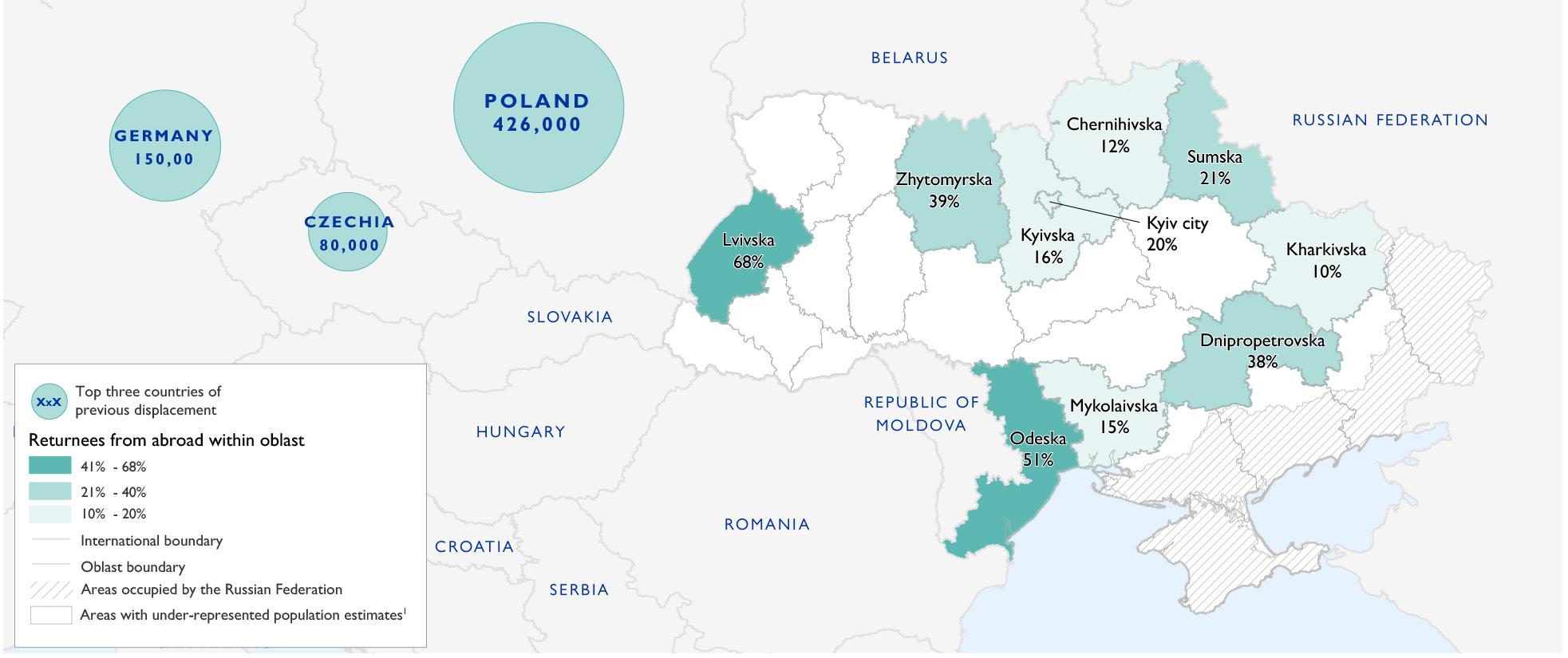
Over a quarter (28%) of all returnees stated that they had spent at least 14 days abroad since February 2022 because of the full-scale war. Returnees from abroad had primarily been displaced in Poland (37%), followed by Germany (13%), Czechia (7%), Italy (6%), Bulgaria and Romania (3% each).
Among returnees who reported returning spontaneously from abroad to their place of habitual residence, the majority (92%) were female. The primary needs reported by returnees from abroad included: food, mentioned by 20 per cent of respondents, followed by reconstruction materials for shelter repairs (5%) and medicines (3%).
5 Estimates in Donetska, Zaporizka, Luhanska, and Khersonska Oblasts are not represented due to their likely under-representation as a result of coverage being limited to government-controlled areas and to the limited number of respondents reached in occupied areas.
6 Ibid.
Table 1: Top 5 oblasts of return
In Round 16, when asked about their plans for future movement, 34 per cent of IDPs (1,213,000 individuals) reported considering moving elsewhere or returning to their area of origin. The vast majority were thinking of returning to their area of origin (31%, est. 1,103,000 IDPs).7 Among those planning to return, 60 per cent said they intend to return to their places of origin after the war is over, while close to one third are not sure when they might return.8
Table 2: Top 5 oblasts of last displacement prior to return9
Two-thirds (66%) of assessed returnees returned a year or more before the time of interview. Notably, more than half of those who returned more than a year before the assessment resided in Kyiv City (22%) and Kyivska Oblast (15%). A further 11 per cent of returnees returned to their place of habitual residence in the three months leading to the assessment date, most notably in Kharkivska (17%) and Kyivska (6%) Oblasts, and Kyiv City (3%). People in the West, North, Kyiv, and Centre on average returned longer ago, while more recent returns were comparatively more concentrated in the East and South.
Figure 3: Top 5 oblasts of return of respondents who returned to their place of habitual residence a year or more prior to data collection (% of returnees)
Returnees spent a median period of three months in displacement (90 days). Forty-seven per cent (47%) of returnees reported having been displaced for three months or longer. When comparing the top five oblasts of last displacement, returnees whose latest place of displacement was located in Mykolaivska, Kharkivska, and Poltavska Oblasts had been displaced the longest (180 days each) prior to return. Returnees whose last place of displacement had been abroad reported having been displaced longer (150 days) than individuals who were displaced within Ukraine prior to return (90 days).
PRIMARY REASONS FOR RELOCATION







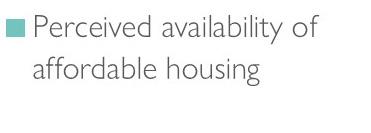

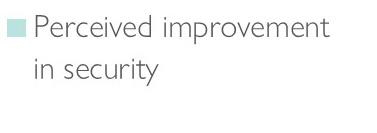


Since March 2022, IOM DTM has conducted surveys with persons crossing back to Ukraine from neighbouring countries to improve the understanding of their profiles, displacement patterns, intentions and needs. 13 In Quarter 1 2024 (Q1), 4,938 individuals were surveyed in border areas and transit places across Hungary, Poland, the Republic of Moldova, Romania, and Slovakia: around 99 per cent of interviewees were Ukrainian, and 1 per cent were Third-Country Nationals (TCNs). Additionally, 10 surveys were collected at border crossing points between Latvia and the Russian Federation with Ukrainians who intended to transit through and reach occupied areas in Ukraine. This section focuses on Ukrainians surveyed during Q1 2024 in neighbouring countries (4,903 individuals) with results weighted by the number of border crossings into Ukraine from each country in the same period.
Table 3: Top 7 oblasts of origin and intended oblast of destination among Ukrainians displaced abroad and returning to Ukraine during Q1 2024 Oblast of
Kyiv City 14%
Odeska 14%
Dnipropetrovska 10%
Zaporizka 8%
Kharkivska 7%
Zakarpatska 5%
Mykolaivska 5%
The share of respondents originating from each oblast in Ukraine varied widely among the respondents in neighbouring countries. Overall, more than half (53%) of respondents resided in just five oblasts prior to being displaced from Ukraine: Kyiv City (14%), Odeska (14%), Dnipropetrovska (10%), Zaporizka (8%), and Kharkivska (7%) Oblasts. A very high proportion of respondents (85%) expressed their intention to return to their oblast of origin upon reentry to Ukraine. Among those planning to travel to another oblast, reasons included concerns about security in their place of origin, knowledge of damage or destruction to their homes, having their family displaced to another area, or knowledge that their homes have been occupied.
Figure 8: Intended length of visit when crossing back during Q1 2024

As in previously assessed periods, the vast majority of respondents crossing back to Ukraine were female (92%). Women were generally younger than men. Three quarters (75%) of women were below 50 years old compared to 46 per cent of men.
An increasing proportion of respondents traveling back travel alone (52% in Q1 2023 and 64% in Q1 2024). Most (56%) primarily resided in the country where the survey was conducted while being outside of Ukraine. The other countries where respondents spent the most time on average were Poland (27%), Germany (12%), Hungary (11%), Czechia (9%), Romania (7%), Slovakia (7%), and Austria (6%). In Q1 2024, the average duration of displacement among respondents was 16 months.
In Q1 2024, TCNs accounted for only 1 per cent of the sample (35 respondents). The top five nationalities among them (including those in Latvia) were: the Russian Federation (10 individuals), the Republic of Moldova (9), Azerbaijan (3), Georgia (2), and Turkey (2).
Over half of those surveyed crossing back (56%) were going to Ukraine for a short visit (one month or less), while 25 per cent expressed their intention to stay (more than a month), and 18 per cent were undecided. The share of those intending to stay for more than one month (prospective returnees) decreased from 38 per cent in Q1 2023 to 25 per cent in Q1 2024. The share of those who do not know how long they will stay in Ukraine increased from 11 per cent in Q1 2023 to 18 per cent in Q1 2024. Men were more likely to indicate their intention to stay (37%) compared to women (24%) in Q1 2024. As in previous assessment periods, the main reported reason for travel to Ukraine during Q4 2023, whether for short visits or returns, was to meet family. This reason was cited by 76 per cent of short-term visitors and 8 per cent of prospective returnees. Additionally, 36 per cent of short-term visitors intended to attend medical appointments in Ukraine and 20 per cent were collecting or renewing identity documents (biometric passports, diplomas, or driving licenses).
In Q1 2024, the four most reported immediate needs individuals anticipate upon arriving at their destination in Ukraine were financial support (41%), personal safety & security (30%), health services (24%), medicine (19%), and employment (11%).
Additionally, in Q1 of 2024, 9 per cent reported experiencing instances of unfair treatment or discrimination while living abroad, an increasing trend since the beginning 2023 (5% in Q1 2023).
A detailed disaggregation of returnee profiles and greater insights into the prevalence of vulnerabilities and household composition enables an enhanced understanding of mobility and is key to effective, targeted humanitarian response. To this end, IOM’s General Population Survey includes indicators –developed in cooperation with the United Nations Population Fund (UNFPA) – which allows for the precise estimated demographic breakdown of the returnee population. This section specifically outlines the estimates for returnee in households consisting exclusively of returnee (household members who, since 24 February 2022, were displaced from their place of habitual residence for at least 14 days due to the war, prior to return).
The majority of returnees resided in large cities (57%), or in small urbantype towns or villages (25%). Ten per cent of returnees returned to rural areas or rural villages (10%). 15
Figure 9: Share of returnees by type of settlement
Suburb of a large city, 8%
Rural area/village, 10%
Small town/ urban-type village, 25%
This section presents the share of returnees who reported that at least one of their current household members16 possessed one of the following characteristics; these traits may contribute to household vulnerability, given: 1. a presumed cost related to the characteristic; 2. a presumed need to access assistance; and 3. potential limitations in getting to or accessing assistance. These characteristics are not mutually exclusive, and individuals may live with one or multiple of the following characteristics.
Figure 10: Percentage of returnee households reporting vulnerable household members (only households containing members having experience of return)17
42%
Est. 1,294,000 male returnees
15 Households consisting exclusively of returnees (66%).
58%
Est. 1,816,000 female returnees
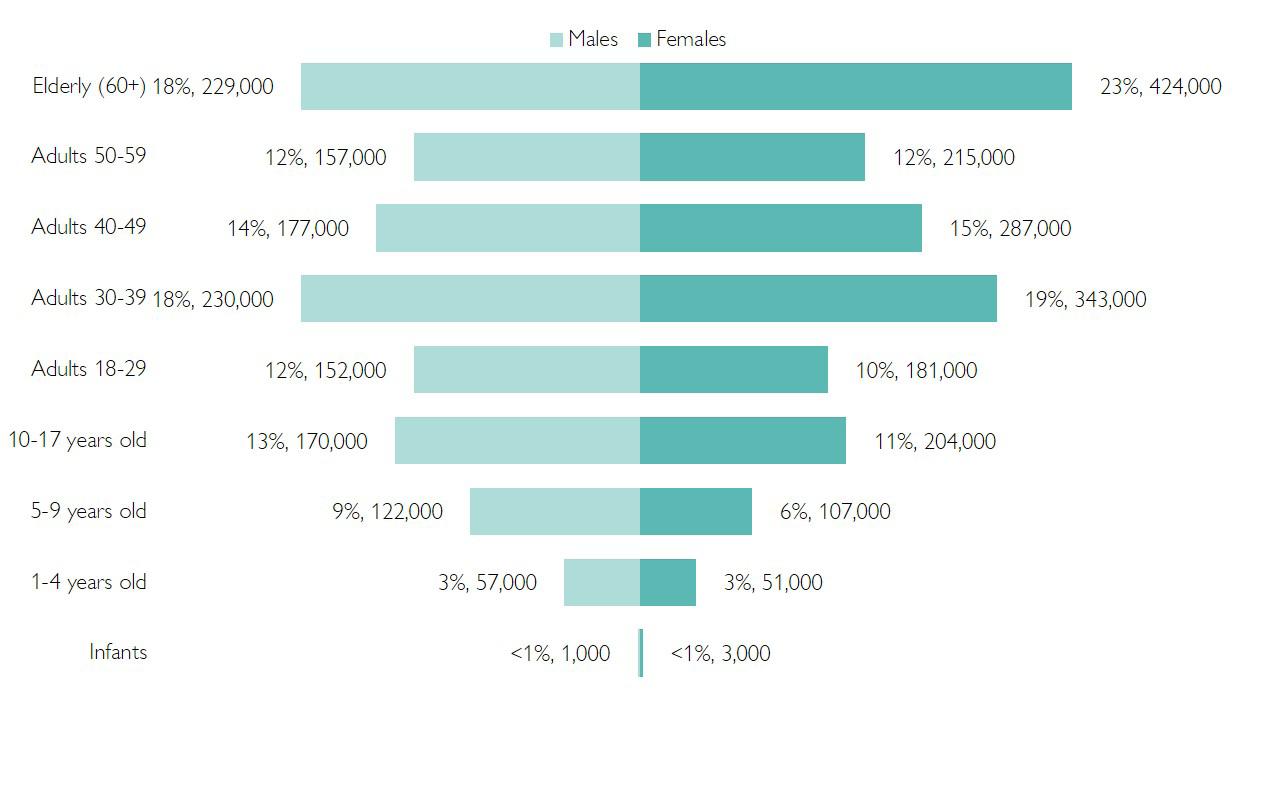
Returnee households (HHs with members who have left their residence due to a large-scale war and have since returned) reported having a median of two household members.21 However, 22 per cent of returnee households had four or more members. The majority of returnee families had one child (63%) with a further 31 per cent reporting two children.
2
1
median returnee household size22 as of April 2024
median number of children per returnee household23 as of April 2024
13a: Number of household members in returnee households (households consisting exclusively of returnees)24

13b: Number of children in returnee households (households consisting exclusively of returnees with children)25

16 The description of the characteristics and demographic profile of returnee household members is based solely on the data for those household members who, since 24 February 2022, were displaced from their place of habitual residence for at least 14 days due to the war, prior return (66% of all returnee households).
17 Households consisting exclusively of returnees.
18, 19To identify disabilities and chronic illnesses in returnee households, respondents were asked whether one or more members in their households lived with a disability or chronic illness. Definitions of disabilities and chronic illnesses were derived from categories defined in the World Health Organization’s International Classification of Functioning, Disability and Health (WHO-ICF). For the purpose of conducting a telephone express survey, the original Washington scale methodology was adapted to make questions shorter and more simplified for respondents.
21, 22, 23 Households consisting exclusively of returnees (66%).
24 The estimated total number returnees is 3,110,000.
25 The estimated total number of children in returnee households is 715,000.
For all populations assessed (IDPs, returnees, and non-displaced populations), food was consistently cited as the top need among respondents. Over a quarter of returnees in Odeska Oblast reported food as their top need (26%), followed by respondents in Kyiv City (19%) and Dnipropetrovska Oblast (18%). However, the majority of returnees in Kyiv City (58%) reported having no material or assistance needs at all, followed by Kyivska Oblast (56%). In comparison, more
conflict-affected oblasts like Mykolaivska (16%) and Kharkivska (14%) Obalsts hosted the greatest shares of returnees reporting building and reconstruction materials as their primary need. This was corroborated by the fact that returnees in Kharkivska Oblast were twice as likely to be living in damaged but livable accommodation (31%), compared to the national average for returnees (15%).
Greater shares of returnees in rural areas reported needs across most sectors, compared to returnees in urban areas.
16: Share of returnees reporting building and reconstruction materials as their top need, by settlement type (% of returnees)

Greater share of returnees having returned more recently reported at least one material or assistance need, in comparison to returnees having returned a year or longer ago.
Single parent households reported marginally greater needs across most sectors, in comparison to households with more than one parent.
Households with members living with disabilities or chronic illnesses reported marginally greater needs across most sectors, in comparison to households without members living with disabilities or chronic illnesses.
Irrespective of rank, returnees reported food among their three main material and assistance needs (25%) with cash as the preferred modality for assistance (38%) or creation of employment opportunities (34%) so that respondents can meet this need sustainably. Returnee respondents also reported needing medicines (11%), clothes and other NFIs (10%), building and reconstruction materials (9%) and health services (8%).27 Similar to IDP respondents,28 when asked the preferred modality to receive assistance in overcoming these challenges, returnees systematically reported cash as their preferred response.
Cash was the preferred modality to receive assistance relating to building materials (62% of returnees needing such assistance reported cash as their preferred modality), medicines (53%), and health services (52%). Unlike IDP respondents, 29 the preference for cash did not constitute the overwhelming majority of responses, with in-kind support and job creation also featuring as desired means of support. For respondents in need of hygiene items (7%), 38 per cent of returnees preferred in-kind support, compared to 42 per cent seeking cash.
Amongst returnees who reported preferring cash assistance, the majority (79%) reported cash to a bank card, such as payment card, pension card or social card, as the most convenient way to receive this cash. This was followed by postal transfer (14%), bank transfers in the cash register in the bank (8%), and prepaid cards (8%).
Figure 17: Share of returnees reporting at least one primary need, by time since return (% of returnees)
of HHs with single parents reported at least one material / assistance need, compared to 46 per cent of HHs without single parents.
of HHs with members living with disabilities reported at least one material / assistance need, compared to 43 per cent of HHs without a member living with disabilities.
of returnee households spent their savings
of returnee households switched to cheaper food and NFIs
of returnee households reduced the usage of utilities
The most prevalent coping strategies employed by returnee households in the 30 days prior to data collection included the spending of savings (mentioned by 57% of returnee respondents) switching to cheaper food and NFIs (55%), alongside reducing utility expenditure (50%)31. Compared to December 2023, the share of returnees having resorted to these coping strategies decreased slightly, but nevertheless remained high. This points to the continued displacement-related vulnerabilities as well as the wider impact of the war on the economy in areas of return.
The impact of the war on the economy affects the whole population. This is reflected in the similar proportion of the IDP, returnee and non-displaced population utilising four to seven coping strategies (40%, 35% and 35%, respectively).
While a higher proportion (13%) of returnees employ no coping strategies when compared with IDPs (4%), return is not commensurate with a reduction in vulnerability for the vast majority (87% of returnees resorting to one or more coping strategies).
Round 14 (September 2023)
Round 15 (December 2023)
Round 16 (April 2024)
REASONS FOR ADOPTING COPING SRATEGIES
When asked the main reason for resorting to such coping strategies, the majority of returnees reported that they employed coping strategies to meet their food and basic needs (55%). Accessing shelter (47%) and healthcare services (44%) were also among the main reasons for resorting to coping strategies. Conversely, few returnees reported accessing education as a driving reason (20%), in accordance with the minimal share of returnees reporting education as a top need (1%). Amongst female and male returnees, respondents noted similar reasons for resorting to coping strategies.
50 per cent of returnee HHs with at least one elderly person, reported their need to afford healthcare as a reason for adopting coping strategies, compared to 40 per cent of HHs without any elderly members.
60 per cent of returnee HHs with at least one child, reported the need for food as motivating the use of coping mechanisms, compared to 52 per cent of HHs with no children.
30 Multiple-choice question.
31 For this round, coping strategies were identified and measured using the Livelihood Coping Strategy Index, measuring the strategies a household employs when it cannot meet basic needs due to inadequate income in times of stress. The Index indicates coping capacity by determining the frequency and severity (weight) of use.
32 Multiple-choice question.
33 The share of returnees who reported 10 on the scale of difficulty accessing/ overcoming, 0 being very difficult, and 10 being easy.
Donetska34 n/a n/a
Zaporizka35 n/a n/a
Luhanska36 n/a n/a
Khersonska37 n/a n/a
Unless noted otherwise, data cited in this report were compiled from Round 16 of the General Population Survey, dated as of 11 April 2024. The data presented in this report was commissioned by the International Organization for Migration (IOM) and collected by 59 enumerators employed by Multicultural Insights through screener phone-based interviews with 20,000 randomly selected respondents and follow-up interviews with 1,427 IDPs, 1,638 returnees, and 2,266 residents, using the computer-assisted telephone interview (CATI) method, and a random digit dial (RDD) approach, with an overall sample error of 0.69% [CL95%]. Round 16 of data collection was completed between 10 March and 11 April 2024. The survey included all of Ukraine, excluding the Crimean Peninsula and occupied areas of Donetska, Luhanska, Khersonska, and Zaporizka Oblasts. All interviews were anonymous, and respondents were asked for consent before starting the interview. IDP and returnee population figures at the national and oblast levels are derived from the July 2023 total population baseline for Ukraine (excluding the Autonomous Republic of Crimea and Sevastopol) defined in the United Nations Population Fund (UNFPA)'s Common Operational Datasets on Population Statistics (COD-PS). All numbers are rounded for ease of use. Estimated figures have been rounded to the nearest 1,000. All numbers are rounded for ease of use. Data collection was facilitated by Multicultural Insights. Additional analysis is available upon request to dtmukraine@iom.int
In this report, Internally Displaced People (IDPs) are defined as individuals who have been forced to flee or to leave their homes or who are staying outside their habitual residence in Ukraine due to the full-scale invasion in February 2022, regardless of whether they hold registered IDP status. The terms "return” and "returnee” are used without prejudice to status and refer to all people who have returned to their habitual residence after a period of displacement of minimum two weeks since February 2022, whether from abroad or from internal displacement within Ukraine. This definition excludes individuals who have come back to Ukraine from abroad but who have not returned to their places of habitual residence in the country. Full definitions of population groups may be found in the Methodological Note
Limitations: Those currently residing outside the territory of Ukraine were not interviewed, following active exclusion. Population estimates assume that minors (those under 18 years old) are accompanied by their adult parents or guardians. The sample frame is limited to adults that use mobile phones, in areas where phone networks were fully functional for the entire period of the survey. People residing in the Autonomous Republic of Crimea (ARC) or the occupied areas of Donetska and Luhanska Oblasts were not included in the survey. Estimates in Donetska, Zaporizka, Luhanska, and Khersonska Oblasts are likely under-represented as a result of coverage being limited to government-controlled areas and to the limited number of respondents reached in occupied areas. For further details on the methodology and sampling design, please refer to the full Methodological Note
34 Estimates in this oblast (blue text) are likely under-represented due to coverage being limited to government-controlled areas, as well as the










https://dtm.iom.int/ukraine